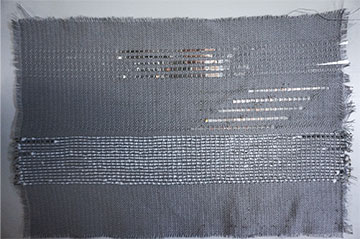
Researchers have developed next-generation smart textiles—incorporating LEDs, sensors and energy-harvesting and storage devices—that can be produced inexpensively, in any shape or size, with the same machines used to make the clothing we wear every day. [Image: S. Lee]
An international team of researchers has developed an integrated textile electronic system with fiber-based electronic components, including photodetectors and quantum dot LEDs (Sci. Adv., doi: 10.1126/sciadv.adf4049). Such technology allows for the low-cost manufacturing of smart textiles that can be woven by machine in any size or shape.
The system, which represents a shift from 2D devices to 1D fiber devices, can be adapted to a wide range of optoelectronic applications in sectors like automotive, electronics, fashion and construction.
Going from 2D to 1D
Previous attempts to integrate electronics into textiles have been hindered by the use of the same rigid wafers used to make integrated circuits. Such conventional, 2D electronic integration results in limited scale, function and size.
“Smart textiles have also been limited by their lack of practicality,” said study author Luigi Occhipinti, University of Cambridge, UK. “You think of the sort of bending, stretching and folding that normal fabrics have to withstand, and it’s been a challenge to incorporate that same durability into smart textiles.”
Occhipinti and his colleagues decided to take a different approach with fiber-based functional devices that can be directly woven into a textile. Devices were fabricated into a fiber form using various techniques, such as vacuum deposition or solution processing, then encapsulated with protective layers to mitigate mechanical damage during the weaving process.
Weaving smart textiles
First, they developed the key fiber components—a photodetector as input device, supercapacitor as energy-storage tool, field-effect transistor as electronic driver and quantum dot LED as output device—and optimized their performance. The photodetector had an on/off ratio of 104 under UV irradiation at 365 nm, while the LED had luminance of over 900 cd/m2.
The researchers then used an industrial weaving machine to create smart textiles that consisted of cotton as a platform, conductive threads and the fiber devices. For instance, a photosensing textile had eight UV-detection positions. The generated signals from each photodetector were sent to a signal collector and then to an indicator such as a display or LEDs. A light-up textile had red, green and blue light emissions from the quantum dot LEDs with a peak luminance of 463, 482 and 188 cd/m2, and electroluminescence peak wavelength of 630, 540 and 450 nm, respectively.
“Building on the capabilities developed in the project, it is possible to conceive the next generation of truly form-factor-free applications, such as building integrated autonomous smart sensor systems, intelligent fabrics and furniture, energy-harvesting smart carpets or curtain-integrated displays, along with e-textile applications in automotive, aerospace and smart cloths,” said Occhipinti.
